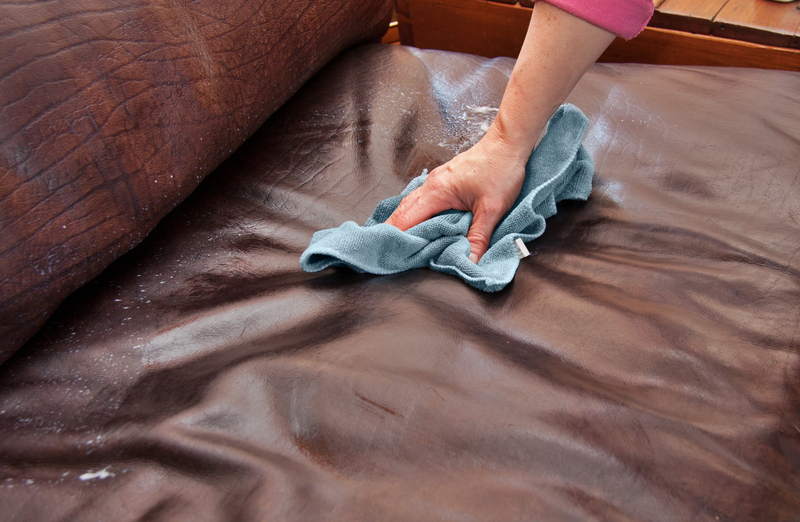Say Goodbye to Mouldy Window Sills with Our Guide
Posted on 03/06/2025
Say Goodbye to Mouldy Window Sills with Our Guide
Are you tired of battling unsightly, musty-smelling mould on your window sills? Discover comprehensive solutions in our ultimate guide to preventing and removing mouldy window sills. Enjoy a fresher, healthier home by following these expert recommendations!

Understanding Why Mould Grows on Window Sills
Mould loves damp environments, and window sills often provide the perfect conditions for growth. This problem isn't just a cosmetic issue; it can also negatively impact indoor air quality and health. So, why exactly do window sills attract mould?
- Condensation: Windows--especially single-glazed or poorly insulated ones--are prone to condensation, leaving window sills damp.
- Poor Ventilation: Rooms with high humidity and low airflow create ideal environments for mould spores to flourish.
- Leaks: Broken window seals or gaps may let water seep in, providing a constant source of moisture.
- Organic Material: Wood, dust, and debris on the sills provide the organic matter mould needs to thrive.
Is Mould on Window Sills Dangerous?
Mouldy window sills aren't just visually unappealing; they also pose health risks. Some people may develop respiratory issues, allergies, or asthma symptoms from inhaling mould spores. Black mould, in particular, is hazardous if left untreated. Knowing the risks underscores the importance of tackling mouldy window sills as soon as possible.
How to Remove Mould from Window Sills: Step by Step
Ready to remove mould from your window sills? First, gather the right tools. Proper removal is essential for preventing further spread and recurrence.
What You'll Need
- Rubber gloves
- Protective goggles and a mask
- Microfiber cloths or sponges
- Spray bottle
- Mild detergent or washing-up liquid
- White vinegar or a specialist mould cleaner
- Baking soda (optional)
- Stiff brush (for wooden window sills)
- Disposable plastic bags (for used cloths)
Step 1: Safety First
Before you start cleaning, open the window for proper ventilation and wear protective gear to shield your eyes, mouth, and skin from spores and cleaning products.
Step 2: Dry the Area
If your window sill is damp, dry it carefully using a clean, absorbent towel. This step helps prevent spreading the mould as you clean.
Step 3: Remove Surface Mould
Lightly dampen a microfiber cloth with warm soapy water and wipe away surface mould, depositing the cloth directly into a disposable plastic bag. For stubborn stains, use a stiff brush.
Step 4: Treat With Vinegar Solution
Fill a spray bottle with a 1:1 solution of white vinegar and water. Spray it generously onto the affected area and leave it for at least 1 hour. Vinegar's acidity destroys most household mould varieties.
Step 5: Scrub and Rinse
Scrub with a clean brush or sponge, then wipe with a fresh damp cloth. Repeat as necessary. If stains persist, sprinkle baking soda onto the affected area, spray with more vinegar, and let it fizz before wiping clean.
Step 6: Dry Thoroughly
Moisture is mould's friend. Use a dry, clean towel to eliminate all remaining moisture from the window sill and ensure the area is well-ventilated while it dries.
Preventing Mouldy Window Sills: Pro Tips
_Stopping mould before it starts is the best way to maintain spotless, healthy window sills._ Here are the most effective ways to prevent mould growth on window sills:
1. Control Humidity
- Use a dehumidifier in moisture-prone rooms.
- Keep humidity below 60% where possible.
2. Increase Ventilation
- Open windows regularly to encourage airflow.
- Use extractor fans in bathrooms and kitchens.
- Install trickle vents on modern windows for continual air movement.
3. Deal With Condensation Promptly
- Wipe away window condensation every morning, especially in winter.
- Consider double-glazing for better insulation and temperature control.
4. Maintain Window Seals
- Check for leaks or cracked caulking around windows. Replace or repair any damaged seals promptly.
- Reseal windows every few years as part of your seasonal home maintenance checklist.
5. Regular Cleaning
- Dust and clean window sills weekly to remove organic particles that attract mould.
- Use a solution of mild detergent and water when necessary, ensuring surfaces stay dry afterwards.
6. Choose the Right Materials
- If renovating, consider non-porous materials like composite or uPVC for window sills, as these are more resistant to mould than untreated timber.
Expert Advice: When to Call in the Professionals
If you notice extensive mould growth extending beyond the window sill--especially if the wall beneath is also affected--you may need professional help. Some types of mould, such as black mould (Stachybotrys chartarum), can be dangerous and require specialist removal to protect your family's health.
Signs you need a mould remediation expert:
- The affected area is larger than one square metre.
- There's a persistent, musty odour despite cleaning efforts.
- You experience worsening allergy or respiratory symptoms in the room.
- Mould keeps returning no matter how often you clean.
Natural Remedies for Mouldy Window Sills
Many homeowners prefer natural cleaning agents over harsh chemicals. While bleach is effective for visible surface cleaning, it can damage paint and is not always necessary. Try these eco-friendly alternatives for your window sills:
- White vinegar: As previously mentioned, vinegar kills up to 82% of mould species. It's inexpensive and safe for most surfaces.
- Baking soda: This household staple is slightly abrasive and absorbs moisture and odours, making it ideal for scrubbing mild mould stains.
- Tea tree oil: With powerful antifungal properties, tea tree oil mixed with water makes a great alternative mould spray.
- Lemon juice: Naturally antibacterial and fragrant, lemon juice can help lift light stains while leaving a pleasant scent.
Steps for Using Natural Removers
- Spray the affected area with your home-made solution.
- Allow it to sit for at least an hour to break down the mould.
- Scrub gently with a sponge or brush.
- Rinse thoroughly and dry the surface well.
Choosing the Best Mould-Resistant Paint for Window Sills
One often-overlooked step in preventing mouldy window sills is choosing the right finish. If you're repainting, opt for mould-resistant or anti-microbial paint. These paints contain additives that stop mould spores from establishing themselves on the painted surface.
- Look for: Paint labeled for bathrooms, kitchens, or high-moisture environments, as these are formulated specifically for areas prone to damp.
- Prep surfaces thoroughly: Clean and dry the window sill, then prime it with a high-quality primer before painting to ensure lasting results.
Window Sill Mould FAQs
Can you just paint over mouldy window sills?
No! Painting over mould simply covers the problem temporarily. Mould will continue to grow underneath and eventually resurface. Always remove all visible mould first and allow the area to dry before repainting.
Is it safe to remove black mould from window sills?
Small patches of black mould can be removed safely if you wear proper protective gear and ventilate the room. However, large infestations should be handled by professionals.
What's the best way to stop condensation on window sills?
Increase ventilation, keep the room temperature consistent, use a dehumidifier, and insulate windows to reduce condensation and, as a result, window sill mould.
Will cleaning window sills stop mould from returning?
Not unless you address the root cause (usually moisture and poor air flow). Regular cleaning helps, but fixing leaks, improving ventilation, and maintaining caulking/seals are vital for long-term mould prevention.

Maintain a Healthy Home: Final Tips and Reminder
Follow these essential tips to keep your window sills mould-free year-round:
- Allow sunlight in regularly: Mould thrives in darkness. Let the sunshine in to naturally inhibit growth.
- Avoid over-watering indoor plants near windows: Excess water can seep into window sills.
- Use moisture-absorbing products: Place silica gel, salt, or commercial moisture absorbers on the sill as a preventive measure.
- Inspect sills often: Early detection means easier clean-up and less risk of damage.
By combining regular cleaning, moisture control, and proper ventilation, you can say goodbye to mouldy window sills and hello to a healthier, more attractive home environment. Don't wait for the problem to escalate; start implementing these expert tips today for pristine sills in every room!
In Summary: Never Struggle with Mouldy Window Sills Again
Mould on window sills can be a persistent household nuisance, but it's far from inevitable. Armed with the right knowledge and proactive care, you'll enjoy bright, clean, and healthy windowsills for years to come. Whether you're dealing with a current outbreak or hoping to avoid future issues, this guide gives you the actionable steps and know-how you need.
For fresher air, peace of mind, and beautiful windows--follow this step-by-step guide and say goodbye to mouldy window sills for good!





